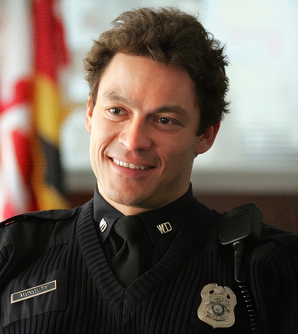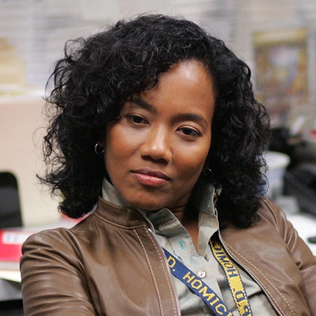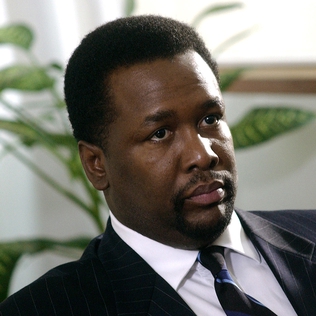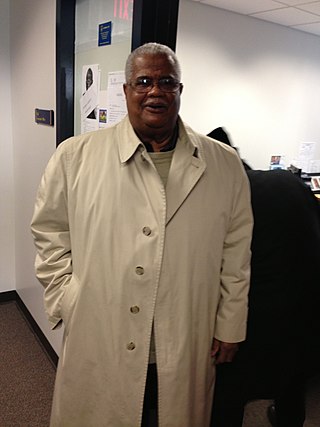
John Munch is a fictional character played by actor Richard Belzer. Munch first appeared on the American crime drama television series Homicide: Life on the Street on NBC. A regular through the entire run of the series from 1993 to 1999, Munch is a cynical detective in the Baltimore Police Department's Homicide unit, and a firm believer in conspiracy theories. He is originally partnered with Detective Stanley Bolander. Munch is based on Jay Landsman, a central figure in David Simon's 1991 true crime book Homicide: A Year on the Killing Streets.

The first season of Homicide: Life on the Street, an American police procedural drama television series, originally aired in the United States on NBC between January 31 and March 31, 1993. The show was created by Paul Attanasio, with film director Barry Levinson and television writer and producer Tom Fontana serving as executive producers. Adapted from David Simon's 1991 non-fiction book Homicide: A Year on the Killing Streets, the season followed the fictional detectives of Baltimore Police Department homicide unit and the murder cases they investigate. The show was broadcast on Wednesdays at 9 p.m. EST, with the exception of the series premiere, which aired immediately after Super Bowl XXVII.
"The Target" is the series premiere of the HBO original series The Wire. The episode was written by David Simon from a story by Simon and Ed Burns and was directed by Clark Johnson. It originally aired on June 2, 2002. The title refers to Detective Jimmy McNulty setting his sights on Stringer Bell and Avon Barksdale's drug-dealing organization as the target of an investigation.

James McNulty is a fictional character and the protagonist of the HBO drama The Wire, played by Dominic West.
"Old Cases" is the fourth episode of the first season of the HBO original series The Wire. The episode was written by David Simon from a story by David Simon and Ed Burns and was directed by Clement Virgo. It originally aired on June 23, 2002.
"One Arrest" is the seventh episode of the first season of the HBO original series The Wire (2002–2008). The episode was written by Rafael Alvarez from a story by David Simon and Ed Burns and was directed by Joe Chappelle. It originally aired on July 14, 2002.

Shakima "Kima" Greggs is a fictional character on the HBO drama The Wire, played by actress Sonja Sohn. Greggs is a determined and capable police detective in the Baltimore Police Department. Openly lesbian, she often displays a hardened, cynical demeanor, and has had problems with infidelity, alcohol, and relationships. She plays a key role in all of her BPD details' main cases.

Lester Freamon is a fictional character on the HBO drama The Wire, played by actor Clarke Peters. Freamon is a detective in the Baltimore Police Department's Major Crimes Unit. He is a wise, methodical detective whose intelligence and experience are often central to investigations throughout the series, particularly with respect to uncovering networks of money laundering and corruption. He sometimes serves as an avuncular figure to several of the characters.

William A. "Bill" Rawls is a fictional character on the HBO drama The Wire, played by actor John Doman. Over the course of the series, Rawls ascends through the higher ranks of the Baltimore Police Department, eventually becoming Deputy Commissioner of Operations and, at the end of Season 5, Superintendent of the Maryland State Police.

William "Bunk" Moreland is a fictional character in The Wire, played by Wendell Pierce. Bunk's character is based on a retired Baltimore detective named Oscar "The Bunk" Requer. He is portrayed as a generally competent, if profane and curmudgeonly detective. Like his best friend Jimmy McNulty, he also has problems related to infidelity and alcohol abuse, although he is more mindful than McNulty of the department's chain of command.

Jay Landsman is a semi-fictional character on the HBO drama The Wire based upon the real life Baltimore City police officer Jay Landsman. The fictional character of Jay Landsman is portrayed by actor Delaney Williams.
The Baltimore Police Department plays an integral part in The Wire.
Law enforcement is an integral part of the HBO drama series The Wire. The show has numerous characters in this field and their roles range from those enforcing the law at street level up to those setting laws citywide. The Baltimore City Police Department has been explored in detail from street level characters to the upper echelons of command. The show has also examined those setting laws in city politics and touched upon the FBI, the correctional system and the family of police officers.
"More with Less" is the first episode of the fifth season of the HBO original series The Wire. The episode was written by David Simon from a story by David Simon & Ed Burns and was directed by Joe Chappelle. It originally aired on January 6, 2008.
"Transitions" is the fourth episode of the fifth season of the HBO original series The Wire. The episode was written by Ed Burns from a story by David Simon & Ed Burns and was directed by Dan Attias, who won the Directors Guild of America Award for Outstanding Directing – Drama Series for the episode. It first aired on January 27, 2008.
Terrence Patrick "Terry" McLarney is a lieutenant assigned to the Baltimore Police Department's Southwestern (8th) District.
Donald "Don" Worden is a retired Baltimore Police Department detective who was featured in David Simon's non-fiction book about the homicide unit, Homicide: A Year on the Killing Streets (1991) and provided the inspiration for the Homicide: Life on the Street television series character Stanley Bolander, played by Ned Beatty.

Oscar "Rick" Requer is a former detective of the Baltimore Police Department.
"Ghost of a Chance" is the second episode of the first season of the American police drama television series Homicide: Life on the Street. It originally aired on NBC in the United States on February 3, 1993. The teleplay was written Noel Behn based on a story by executive producer Tom Fontana, and the episode was directed by Martin Campbell. In it Bayliss begins his investigation into the murder of 11-year-old Adena Watson, Munch and Bolander investigate the unusual death of an elderly man, and Howard insists she is receiving advice about her murder case from a ghost.
Roger Nolan is a former sergeant of the Baltimore Police Department's Homicide Unit. He is notable for being a Homicide Squad Supervisor, alongside fellow sergeants Terry McLarney and Jay Landsman, under the command of Lieutenant Gary D'Addario, whose work was featured in David Simon's Homicide: A Year on the Killing Streets book. A native of West Baltimore and a former Marine, Nolan joined the department in 1963 working in the State's Attorney's Unit, and the Western, Eastern, and Northwestern Districts, before becoming a supervisor in the department's Homicide Unit.








